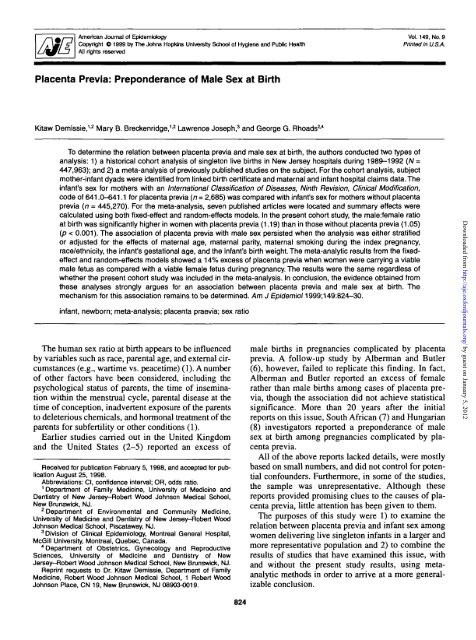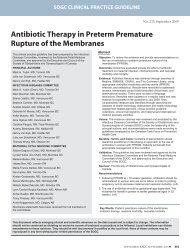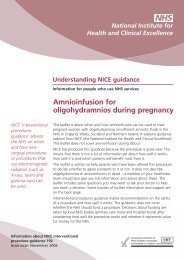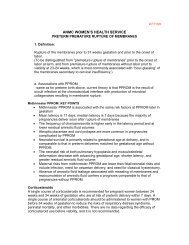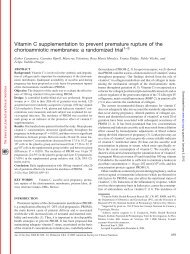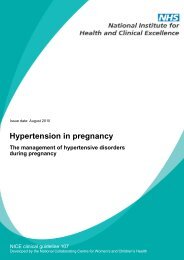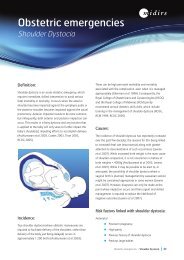Placenta Previa: Preponderance of Male Sex at Birth
Placenta Previa: Preponderance of Male Sex at Birth
Placenta Previa: Preponderance of Male Sex at Birth
- No tags were found...
Create successful ePaper yourself
Turn your PDF publications into a flip-book with our unique Google optimized e-Paper software.
American Journal <strong>of</strong> EpidemiologyCopyright O 1999 by The Johns Hopkins University School <strong>of</strong> Hygiene and Public HealthAll rights reservedVol. 149, No. 9Printed In U.SA,<strong>Placenta</strong> <strong>Previa</strong>: <strong>Preponderance</strong> <strong>of</strong> <strong>Male</strong> <strong>Sex</strong> <strong>at</strong> <strong>Birth</strong>Kitaw Demissie, 1 ' 2 Mary B. Breckenridge, 1 - 2 Lawrence Joseph, 3 and George G. Rhoads 2 - 4To determine the rel<strong>at</strong>ion between placenta previa and male sex <strong>at</strong> birth, the authors conducted two types <strong>of</strong>analysis: 1) a historical cohort analysis <strong>of</strong> singleton live births in New Jersey hospitals during 1989-1992 (N =447,963); and 2) a meta-analysis <strong>of</strong> previously published studies on the subject. For the cohort analysis, subjectmother-infant dyads were identified from linked birth certific<strong>at</strong>e and m<strong>at</strong>ernal and infant hospital claims d<strong>at</strong>a. Theinfant's sex for mothers with an Intern<strong>at</strong>ional Classific<strong>at</strong>ion <strong>of</strong> Diseases, Ninth Revision, Clinical Modific<strong>at</strong>ion,code <strong>of</strong> 641.0-641.1 for placenta previa (n = 2,685) was compared with infant"s sex for mothers without placentaprevia (n = 445,270). For the meta-analysis, seven published articles were loc<strong>at</strong>ed and summary effects werecalcul<strong>at</strong>ed using both fixed-effect and random-effects models. In the present cohort study, the male:female r<strong>at</strong>io<strong>at</strong> birth was significantly higher in women with placenta previa (1.19) than in those without placenta previa (1.05)(p < 0.001). The associ<strong>at</strong>ion <strong>of</strong> placenta previa with male sex persisted when the analysis was either str<strong>at</strong>ifiedor adjusted for the effects <strong>of</strong> m<strong>at</strong>ernal age, m<strong>at</strong>ernal parity, m<strong>at</strong>ernal smoking during the index pregnancy,race/ethnicity, the Infant's gest<strong>at</strong>ional age, and the Infant's birth weight. The meta-analytic results from the fixedeffectand random-effects models showed a 14% excess <strong>of</strong> placenta previa when women were carrying a viablemale fetus as compared with a viable female fetus during pregnancy. The results were the same regardless <strong>of</strong>whether the present cohort study was included in the meta-analysis. In conclusion, the evidence obtained fromthese analyses strongly argues for an associ<strong>at</strong>ion between placenta previa and male sex <strong>at</strong> birth. Themechanism for this associ<strong>at</strong>ion remains to be determined. Am J Epidemiol 1999; 149:824-30.infant, newborn; meta-analysis; placenta praevia; sex r<strong>at</strong>ioThe human sex r<strong>at</strong>io <strong>at</strong> birth appears to be influencedby variables such as race, parental age, and external circumstances(e.g., wartime vs. peacetime) (1). A number<strong>of</strong> other factors have been considered, including thepsychological st<strong>at</strong>us <strong>of</strong> parents, the time <strong>of</strong> insemin<strong>at</strong>ionwithin the menstrual cycle, parental disease <strong>at</strong> thetime <strong>of</strong> conception, inadvertent exposure <strong>of</strong> the parentsto deleterious chemicals, and hormonal tre<strong>at</strong>ment <strong>of</strong> theparents for subfertility or other conditions (1).Earlier studies carried out in the United Kingdomand the United St<strong>at</strong>es (2-5) reported an excess <strong>of</strong>Received for public<strong>at</strong>ion February 5,1998, and accepted for public<strong>at</strong>ionAugust 25, 1998.Abbrevi<strong>at</strong>ions: Cl, confidence interval; OR, odds r<strong>at</strong>io.1 Department <strong>of</strong> Family Medicine, University <strong>of</strong> Medicine andDentistry <strong>of</strong> New Jersey-Robert Wood Johnson Medical School,New Brunswick, NJ.2 Department <strong>of</strong> Environmental and Community Medicine,University <strong>of</strong> Medicine and Dentistry <strong>of</strong> New Jersey-Robert WoodJohnson Medical School, Pisc<strong>at</strong>away, NJ.3 Division <strong>of</strong> Clinical Epidemiology, Montreal General Hospital,McGill University, Montreal, Quebec, Canada.4 Department <strong>of</strong> Obstetrics, Gynecology and ReproductiveSciences, University <strong>of</strong> Medicine and Dentistry <strong>of</strong> NewJersey-Robert Wood Johnson Medical School, New Brunswick, NJ.Reprint requests to Dr. Kitaw Demissie, Department <strong>of</strong> FamilyMedicine, Robert Wood Johnson Medical School, 1 Robert WoodJohnson Place, CN 19, New Brunswick, NJ 08903-0019.male births in pregnancies complic<strong>at</strong>ed by placentaprevia. A follow-up study by Alberman and Butler(6), however, failed to replic<strong>at</strong>e this finding. In fact,Alberman and Butler reported an excess <strong>of</strong> femaler<strong>at</strong>her than male births among cases <strong>of</strong> placenta previa,though the associ<strong>at</strong>ion did not achieve st<strong>at</strong>isticalsignificance. More than 20 years after the initialreports on this issue, South African (7) and Hungarian(8) investig<strong>at</strong>ors reported a preponderance <strong>of</strong> malesex <strong>at</strong> birth among pregnancies complic<strong>at</strong>ed by placentaprevia.All <strong>of</strong> the above reports lacked details, were mostlybased on small numbers, and did not control for potentialconfounders. Furthermore, in some <strong>of</strong> the studies,the sample was unrepresent<strong>at</strong>ive. Although thesereports provided promising clues to the causes <strong>of</strong> placentaprevia, little <strong>at</strong>tention has been given to them.The purposes <strong>of</strong> this study were 1) to examine therel<strong>at</strong>ion between placenta previa and infant sex amongwomen delivering live singleton infants in a larger andmore represent<strong>at</strong>ive popul<strong>at</strong>ion and 2) to combine theresults <strong>of</strong> studies th<strong>at</strong> have examined this issue, withand without the present study results, using metaanalyticmethods in order to arrive <strong>at</strong> a more generalizableconclusion.Downloaded from http://aje.oxfordjournals.org/ by guest on January 5, 2012824
830 Demissie et al.ty. Br J Prev Soc Med 1956; 10:19-24.3. Rhodes P. <strong>Sex</strong> <strong>of</strong> the fetus in antepartum hemorrhage. Lancet1965;2:718-19.4. Hibbard BM. Foetal sex in antepartum hemorrhage. (Letter).Lancet 1965;2:955-6.5. Brenner WE, Edelman DA, Hendricks CH. Characteristics <strong>of</strong>p<strong>at</strong>ients with placenta previa and results <strong>of</strong> "expectant management."Am J Obstet Gynecol 1978;132:180-91.6. Alberman ED, Butler NR. <strong>Sex</strong> r<strong>at</strong>io and bleeding in pregnancy.(Letter). Lancet 1966;1:711.7. MacGillivray I, Davey D, Isaacs S. <strong>Placenta</strong> praevia and sexr<strong>at</strong>io <strong>at</strong> birth. Br Med J (Clin Res Ed) 1986;292:371-2.8. Jakobovits AA, Zubek L. <strong>Sex</strong> r<strong>at</strong>io and placenta praevia. ActaObstet Gynecol Scand 1989;68:503-5.9. Commission on Pr<strong>of</strong>essional and Hospital Activities, HealthCare Financing Administr<strong>at</strong>ion. Intern<strong>at</strong>ional classific<strong>at</strong>ion <strong>of</strong>diseases, ninth revision, clinical modific<strong>at</strong>ion. 3rd ed.Washington, DC: US GPO, 1989.10. Armitage P. St<strong>at</strong>istical methods in medical research. London,England: Blackwell Scientific Public<strong>at</strong>ions, 1980:131-8,426-33.11. Kleinbaum DG, Kupper LL, Morgenstern H. Epidemiologicresearch: principles and quantit<strong>at</strong>ive methods. Belmont, CA:Lifetime Learning Public<strong>at</strong>ions, 1982:419-46.12. Eddy DM, Hasselblad V, Shachter R. Meta-analysis by theconfidence pr<strong>of</strong>ile method. New York, NY: Academic Press,Inc. 1992.13. Lavery JP. <strong>Placenta</strong> previa. Clin Obstet Gynecol 1990,33:414-21.14. Mabie WC. <strong>Placenta</strong> previa. Clin Perin<strong>at</strong>ol 1992; 19:425-35.15. Iyasu S, Saftlas AK, Rowley DL, et al. The epidemiology <strong>of</strong>placenta previa in the United St<strong>at</strong>es, 1979 through 1987. Am JObstet Gynecol 1993; 168:1424-9.16. Fisher ES, Whaley FS, Krush<strong>at</strong> WM, et al. The accuracy <strong>of</strong>Medicare's hospital claims d<strong>at</strong>a: progress has been made, butproblems remain. Am J Public Health 1992;82:243-8.17. Kerr MG, Rashad MN. <strong>Sex</strong> r<strong>at</strong>io and bleeding in pregnancy.(Letter). Lancet 1966;1:711.18. Novitski E, Kimball AW. <strong>Birth</strong> order, parental ages and sex <strong>of</strong><strong>of</strong>fspring. Am J Hum Genet 1958;10:257-68.Downloaded from http://aje.oxfordjournals.org/ by guest on January 5, 2012Am J Epidemiol Vol. 149, No. 9, 1999


